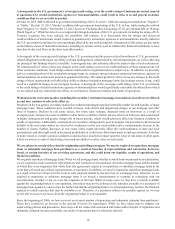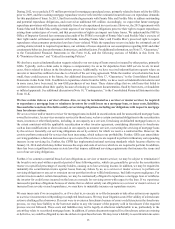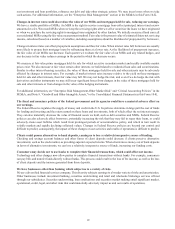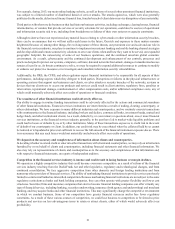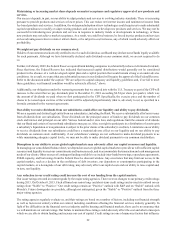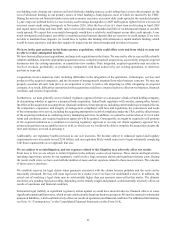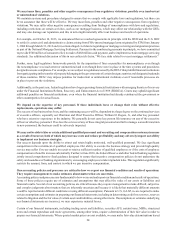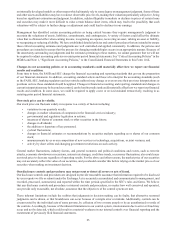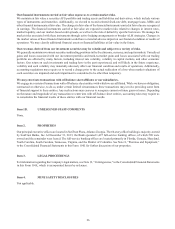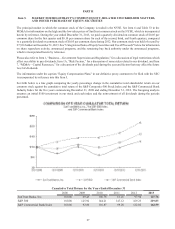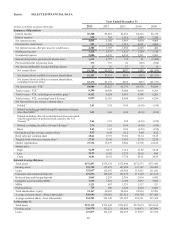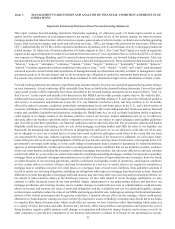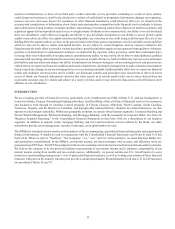SunTrust 2013 Annual Report Download - page 39
Download and view the complete annual report
Please find page 39 of the 2013 SunTrust annual report below. You can navigate through the pages in the report by either clicking on the pages listed below, or by using the keyword search tool below to find specific information within the annual report.23
our funding costs. Among our various retail and wholesale funding sources, credit ratings have a more direct impact on the
cost of wholesale funding, as our primary source of retail funding is bank deposits, most of which are insured by the FDIC.
During the most recent financial market crisis and economic recession, our senior debt credit spread to the matched maturity
5-year swap rate widened before we received any credit ratings downgrades in 2009 and began to tighten before we received
our most recent credit rating downgrade in November 2010. After the loss of our A-1 short-term credit rating in April 2009
and capital raises in May and June 2009, more recent credit rating downgrades had little or no detrimental impact to our debt
credit spreads. We expect that a one notch downgrade would have a relatively small impact on our debt credit spreads. A one
notch downgrade could impact our ability to maintain certain business deposits that are sensitive to credit ratings. If we were
not able to maintain these deposits, we would have to replace this funding with wholesale or capital markets funding, which
would be more expensive and therefore negatively impact our net interest margin and net interest income.
We have in the past and may in the future pursue acquisitions, which could affect costs and from which we may not
be able to realize anticipated benefits.
We have historically pursued acquisitions, and may seek acquisitions in the future. We may not be able to successfully identify
suitable candidates, negotiate appropriate acquisition terms, complete proposed acquisitions, successfully integrate acquired
businesses into the existing operations, or expand into new markets. Once integrated, acquired operations may not achieve
levels of revenues, profitability, or productivity comparable with those achieved by our existing operations, or otherwise
perform as expected.
Acquisitions involve numerous risks, including difficulties in the integration of the operations, technologies, services and
products of the acquired companies, and the diversion of management's attention from other business concerns. We may not
properly ascertain all such risks prior to an acquisition or prior to such a risk impacting us while integrating an acquired
company. As a result, difficulties encountered with acquisitions could have a material adverse effect on our business, financial
condition, and results of operations.
Furthermore, we must generally receive federal regulatory approval before we can acquire a bank or bank holding company.
In determining whether to approve a proposed bank acquisition, federal bank regulators will consider, among other factors,
the effect of the acquisition on competition, financial condition, future prospects, including current and projected capital levels,
the competence, experience, and integrity of management, compliance with laws and regulations, the convenience and needs
of the communities to be served, including the acquiring institution's record of compliance under the CRA, and the effectiveness
of the acquiring institution in combating money laundering activities. In addition, we cannot be certain when or if, or on what
terms and conditions, any required regulatory approvals will be granted. Consequently, we might be required to sell portions
of the acquired institution as a condition to receiving regulatory approval or we may not obtain regulatory approval for a
proposed acquisition on acceptable terms or at all, in which case we would not be able to complete the acquisition despite the
time and expenses invested in pursuing it.
Additionally, our regulatory burden increases as our size increases. We become subject to enhanced capital and liquidity
requirements once our assets exceed $250 billion, and our regulators likely would expect us to begin voluntarily complying
with those requirements as we approach that size.
We are subject to certain litigation, and our expenses related to this litigation may adversely affect our results.
From time to time we are subject to certain litigation in the ordinary course of our business. These claims and legal actions,
including supervisory actions by our regulators, could involve large monetary claims and significant defense costs. During
the recent credit crisis, we have seen both the number of cases and our expenses related to those cases increase. The outcome
of these cases is uncertain.
We establish reserves for legal claims when payments associated with the claims become probable and the costs can be
reasonably estimated. We may still incur legal costs for a matter even if we have not established a reserve. In addition, the
actual cost of resolving a legal claim may be substantially higher than any amounts reserved for that matter. The ultimate
resolution of a pending legal proceeding, depending on the remedy sought and granted, could materially adversely affect our
results of operations and financial condition.
Substantial legal liability or significant regulatory action against us could have material adverse financial effects or cause
significant reputational harm to us, which in turn could seriously harm our business prospects. We may be exposed to substantial
uninsured liabilities, which could adversely affect our results of operations and financial condition. For additional information,
see Note 19, “Contingencies,” to the Consolidated Financial Statements in this Form 10-K.



